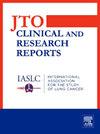提供者行为决定因素和肺癌筛查实施的偏好:简要报告
IF 3.5
Q2 ONCOLOGY
引用次数: 0
摘要
肺癌筛查的实施并不理想。了解卫生保健提供者的偏好和行为对实施很重要。在这项工作中,使用理论域框架报告了提供者对肺癌筛查实施的偏好和肺癌筛查行为的自我报告决定因素。方法在这项混合方法评估中,对9家退伍军人事务部的卫生保健提供者进行了调查,列出了影响他们决定在自由文本回复中筛查肺癌患者的因素,并根据临床实践中的有用性对实施策略进行了排名。对自由文本数据进行编码并映射到理论域框架。定量排名数据被描述性地整体分析,并按专业(初级保健与放射学)、诊所环境(医院与社区)和提供者类型(医生与高级执业提供者)进行分析。结果在分析的234/254名符合条件的医疗服务提供者中,以初级保健(83.8%)、社区(52.1%)和医生(66.2%)居多。受访者认为社会影响(69.2%)、知识(55.6%)、环境背景和资源(15.4%)是有影响的行为决定因素。总体而言,患者提醒(29.9%)、提供者提醒(26.1%)和学习协作(24.4%)被报道为最常用的实施策略。策略偏好因专业、实践环境和提供者类型而异:初级保健(30.1%)、医生(34.2%)和医院(33.0%)提供者最常对患者提醒进行排名;放射科医生最常被评为协作学习(42.1%);高级执业医生(24.1%)和社区医生(27.0%)最常将医生提醒列为最有用的。结论针对三个行为决定因素(社会影响、知识、环境背景和资源)设计实施策略,并根据提供者的偏好量身定制,可以有效改变提供者的肺癌筛查行为。本文章由计算机程序翻译,如有差异,请以英文原文为准。
Provider Behavioral Determinants and Preferences for Lung Cancer Screening Implementation: A Brief Report
Introduction
Implementation of lung cancer screening is suboptimal. Understanding health care provider preferences and behavior is important for implementation. In this work, provider preferences for lung cancer screening implementation and self-reported determinants of lung cancer screening behavior were reported using the theoretical domains framework.
Methods
In this mixed-methods evaluation, health care providers at nine Veterans Affairs were surveyed to list factors influencing their decision to screen patients for lung cancer in free-text responses and rank implementation strategies by usefulness in clinical practice. Free-text data were coded and mapped to the theoretical domains framework. Quantitative ranking data were descriptively analyzed overall and by specialty (primary care versus radiology), clinic setting (hospital versus community), and provider type (physician versus advanced practice provider).
Results
Of 234/254 eligible providers analyzed, most were primary care (83.8%), community-based (52.1%), and physicians (66.2%). Respondents identified social influences (69.2%), knowledge (55.6%), and environmental context and resources (15.4%) as influential behavioral determinants. Overall, patient reminders (29.9%), provider reminders (26.1%), and learning collaboratives (24.4%) were reported most frequently as useful implementation strategies. Strategy preferences differed by specialty, practice setting, and provider type: primary care (30.1%), physician (34.2%), and hospital-based (33.0%) providers most frequently ranked patient reminders; radiology providers most frequently ranked learning collaborative (42.1%); advanced practice providers (24.1%) and community-based providers (27.0%) most frequently ranked provider reminders as most useful.
Conclusions
Designing implementation strategies that target three behavioral determinants (social influences, knowledge, and environmental context and resources) and are tailored to providers’ preferences may effectively change providers’ lung cancer screening behavior.
求助全文
通过发布文献求助,成功后即可免费获取论文全文。
去求助
来源期刊

JTO Clinical and Research Reports
Medicine-Oncology
CiteScore
4.20
自引率
0.00%
发文量
145
审稿时长
19 weeks
 求助内容:
求助内容: 应助结果提醒方式:
应助结果提醒方式:


